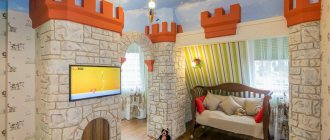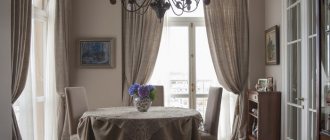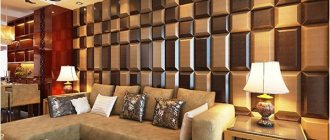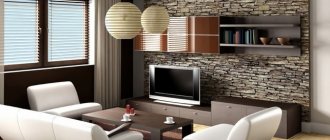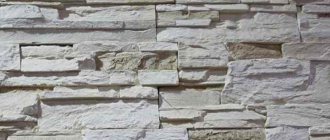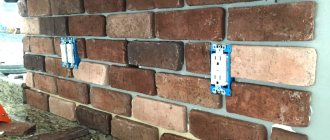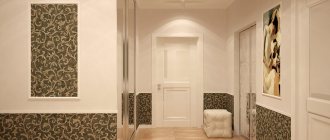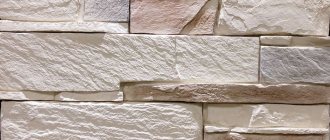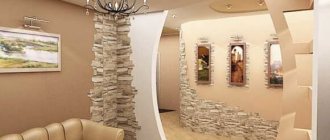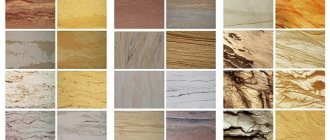Advantages of artificial stone in design
- Stone tiles withstand mechanical stress well. A variegated pattern and dark shades will help maintain a presentable appearance of the sections of walls around the door, sockets and mirrors for a long time.
- Stone is always perceived as an elite material. Therefore, it easily fits into luxury apartments in a classic style.
- Modern ethnic design trends readily use stone finishing in measured quantities.
- High-quality stone imitation helps to fit photo wallpaper with a deep perspective into the interior (windows, terraces, patios, etc.).
- Mirrors benefit from this proximity, since the rough surface absorbs excess glare.
- Decorative stone is fireproof.
- Does not emit toxic substances, safe for health.
- The material can withstand large temperature changes, which allows it to be used in the kitchen.
- Resistant to mold and mildew.
A natural stone
Natural material has many advantages. It is very relevant, often chosen by people who are lovers of everything natural. Indeed, the material cannot but attract attention due to its magnificent natural beauty.
Finishing a kitchen with stone is becoming an attractive solution due to its good properties. The list of advantages also includes a luxurious appearance. This makes it possible to create a chic interior with a unique atmosphere.
There are also certain disadvantages. The main point is the fairly high cost, so not everyone can afford to purchase such material.
Features you need to know
In conditions of limited space, it is advisable to lay stone tiles in fragments. Otherwise, the effect of a dungeon or monastic cell will be created.
Spacious hallways in private mansions and cottages can afford to use an accent wall decorated with stone tiles instead of individual fragments. It should be taken into account that thin plasterboard partitions are not able to withstand the impressive load from full-weight sandstone or granite. In this case, it is better to use high-quality gypsum imitations. They are no less expressive and unusually light.
You should also carefully use natural stone when designing semicircular arched spans. Give preference to either thinly sliced slabs or gypsum tiles. Cement imitations can also be used. In any case, take into account the weight of the decorative material and the strength of the frame located inside the partitions.
Proper lighting plays an important role, which can completely depersonalize the texture of the stone or reveal it in all its glory. Front rays provide a minimum of shadows and smooth out the wall topography. Lamps that direct the flow of light from above and below allow you to create a play of shadows that reveals the volume and texture of each tile. Lighting must be thought out carefully so that each spot and sconce work for the overall result.
Color palette
As a rule, natural shades are chosen to decorate the hallway: gray, brown, plaster. Bright red, burgundy, yellow tones, universal sand and white options are popular. Exotic shades are also used in modern style.
Light materials will visually enlarge the space, while dark materials will make the room even smaller, which is why they are most often used as accents in hallways. Look at the photo.
Popular design options include imitation granite, marble, pebbles, sandstone, and quartz. To soften the severity of stone coverings, use textiles in light shades. Look at the photo.
So, recommendations for combining colors in the interior of the corridor:
- dark decorative stone will benefit from wallpaper in light white, yellow, pastel, milky, peach, and cream tones;
- The decoration of the corridor is characterized by balance in design, so use contrasting combinations with caution;
- artificial stone coverings should be two shades darker than the wallpaper;
- For white decorative materials with stone imitation, plain wallpaper of the same color is best suited.
The photo below shows a combination of stone coverings and light-colored wallpaper.
Combination of stone tiles and wallpaper
The stone goes well with all types of plaster, decorative putty, paint and wallpaper.
Since stone decor is quite expensive and labor-intensive, wallpaper provides an opportunity to reduce costs and speed up repairs.
Loft
The loft deliberately shows the material of the walls, the industrial filling of old industrial premises, converted into residential apartments and houses.
A piece of wall that the builders “forgot” to plaster and wallpaper will serve as the basis for a light hanger model.
The red brick that frames the mirror will remind you of the era of construction booms. This style is generally characterized by the use of thin tiles imitating brick and natural stone in combination with modern wallpaper of moderate colors and calm tones.
Common varieties
Considering the main types of finishing stone, it should be noted that they are somewhat different from each other. What exactly is the difference between them? One of the classifications is based on the origin of a particular material. So, the stone can be either natural or artificial. We will now provide a brief description of the characteristics and features of each of these types.
Fake diamond
Recently, the use of artificial stone to decorate the walls of rooms has become increasingly common. It can be used either alone or in combination with wallpaper. The growing popularity is by no means accidental, since it is due to numerous advantages. Let's list the main advantages:
- Inexpensive in price.
- It is light in weight compared to its natural “brothers”.
- Strong and durable.
Of course, artificial stone must be produced on the basis of some kind of raw material, which, in turn, is of natural origin. In most cases, cement or gypsum is used as the base. Gypsum tiles have their advantages and disadvantages, just like any other material. On the one hand, it is characterized by excellent aesthetic characteristics, which makes this material very attractive. It can be used in the hall and bedroom. On the other hand, installing this type of finishing in the corridor, as well as in the loggia and toilet (you can read about wallpaper in the toilet in more detail in this article) may raise certain questions, because withstanding high levels of moisture is not one of its strengths.
On the other hand, decorative cement stone is more resistant to use in rooms with higher moisture levels. Therefore, this coating can be safely used in the hallway, kitchen, dining room and even in the bathroom.
Imitation of other materials
Any artificial coating has one feature: it is designed, to one degree or another, to imitate one of the natural materials. Artificial stone for interior decoration is no exception. Thanks to the variety of various options offered by various manufacturers, buyers have the opportunity to select the necessary finishing surfaces for almost any interior style. In addition, we must not forget about the many possibilities for combining in the interior. Wallpaper (vinyl, paper, non-woven and other types) can also act as companions, of course.
Let's look at the most popular "samples" for copying:
- Slate. An interesting material with a unique surface allows you to create very unusual interiors, as well as combinations. Due to its appearance, the illusion of a uniform surface is created.
- Natural stone. Perhaps the most popular type of imitation. As a matter of fact, this is why the material acquired its name: artificial STONE.
- Ceramic clinker brick. The tile, which is designed to imitate real brick, can be painted in any color. In addition, its texture can also be different: from completely smooth, to rough and slightly “aged”. By the way, artificially aged materials are often used in the Provence style, which you can learn more about by reading this material.
Natural materials
So, before answering the question of whether it is possible to glue decorative stone to wallpaper, let's look at the types of materials that are of natural origin and were not made artificially from one or another raw material. A special feature of this type of wall decoration is the significant cost of both the material itself and the work required to install it correctly and beautifully. In addition, unlike some artificial analogues, it is characterized by considerable weight, which makes transporting and laying such stone more difficult tasks.
There are 4 main materials of natural origin:
- The easiest way to do the installation yourself is in cases where you use sandstone. Its common colors are green, yellowish, brown, beige, red.
- A more expensive and heavier stone that suits a more formal style is granite.
- Similar words can be said about marble, which is the optimal solution for classic interiors.
- And finally, limestone. It is, in some ways, similar to sandstone, due to its relatively simple installation and lighter weight compared to granite and marble.
Interesting to know! This material is also known as “wild stone”.
Provence
Despite the fact that this style gravitates more toward wooden boards, clay, lime whitewash and light pastel colors, there is always a place for stone in a Provencal interior.
Choose light colors and large blocks. Sometimes it is possible to combine tiles that imitate white brick and wood well.
The stone is good with elegant fine forging. It works great in tandem with stylish wrought iron sconces. Wall lighting will provide light shadows that highlight the voluminous texture of the tiles.
Combination of stone with other finishing options
There should not be too much stone, otherwise the interior will appear overly busy, and if you choose cold shades, even uncomfortable. Therefore, it is customary to dilute it with other materials.
With plaster
Despite common misconceptions, plaster is no less environmentally friendly material than stone. Therefore, this combination in the kitchen looks quite optimal. A variant of combining such a “duet” has already been given above.
Nevertheless, this combination is quite rare and is mainly used, for example, in the hallway. If decorative stone is used in the kitchen, this makes it possible to continue these motifs in the adjacent corridor.
Finishing the hallway and corridor using plaster
With a tree
A “stone-like” kitchen with wooden elements is a direct fit into eco-style. These materials traditionally harmonize in nature, which means they fit perfectly together in the kitchen interior.
Often, this combination is found in an effort to adhere to the traditional North American country style, where gray massive “wild” stone and heavy timber are usually used (you can also find weave with bamboo).
Country style stone kitchen
Kitchen decoration with decorative stone and wallpaper
Wallpaper is still popular and will not give way to painted walls. As for the kitchen, the combination of a plain fabric and the local use of stone is quite appropriate here. What is important is that you should not glue wallpaper with a relief or a large pattern. Experience shows that the materials will be discordant with each other and in this case it will be difficult to achieve a cohesive interior.
To simplify the task, it is worth choosing wallpaper to match the stone, and not vice versa. It’s better to avoid photo wallpapers altogether.
The big advantage of wallpaper is that you can achieve the contrast you need and at the same time choose the color scheme to match the set.
A small life hack. When performing finishing work, you should first stick stone on the walls, but leave the edges empty. Then paste the wallpaper so that it covers the left spaces, and then “finish the mosaic.”
Kitchen decoration with artificial stone and wallpaper
It's always interesting to peek through a crack
A mirrored cabinet and a photo print framed in stone will allow you to be transported to the Mediterranean and feel like an archaeologist. Glue gypsum tiles imitating marble or limestone on top of the photo wallpaper. Imagine the composition as a gap in an ancient wall, through which the walls of the old city are visible or a view of the seascape opens up. The view of the winding streets “running away” into the distance is also good.
Stone tiles allow you to make a beautiful transition to the image and add realism to the picture.
Corners and arches
Corners and arches experience particularly powerful mechanical stress. This is where wallpaper likes to peel up and stains appear.
The area above the baseboard is subject to pressure from the claws and teeth of pets and wet children's boots.
Stone and porcelain tiles help to maximize the durability of fresh renovations, because... They are resistant to stains and retain their color and shape for a long time.
Niches
Stone niches look good in classic, Provence and loft styles. Here you can place a mirror or several shelves for gloves, keys and hats.
But the special chic is the art gallery in improvised niches framed in precious stone. This idea can be easily implemented in country cottages. For Soviet-era apartments, such an idea is only possible if there is an adjoining long corridor.
Interesting ideas
So, let's see what we can do to unusually decorate the walls with decorative stone and wallpaper in the hallway?
- Apply jagged edges to make the walls look voluminous.
- Install spotlights to highlight the cladding.
- Add various decorations to the wall. Mirrors, paintings, fakes and compositions will be used.
- Create a living corner.
- In the classical direction, place stone on the columns, emphasizing the overall ambiance.
- Hang shelves to store small items.
Decorating the walls in the hallway and kitchen with decorative stone and wallpaper in the photo (real examples):
The combination of wallpaper and stone looks elegant, and with skillful design can produce a striking effect on guests. Especially in combination with design styles such as loft, Provence and Mediterranean.
Mar 4, 2017Werri
